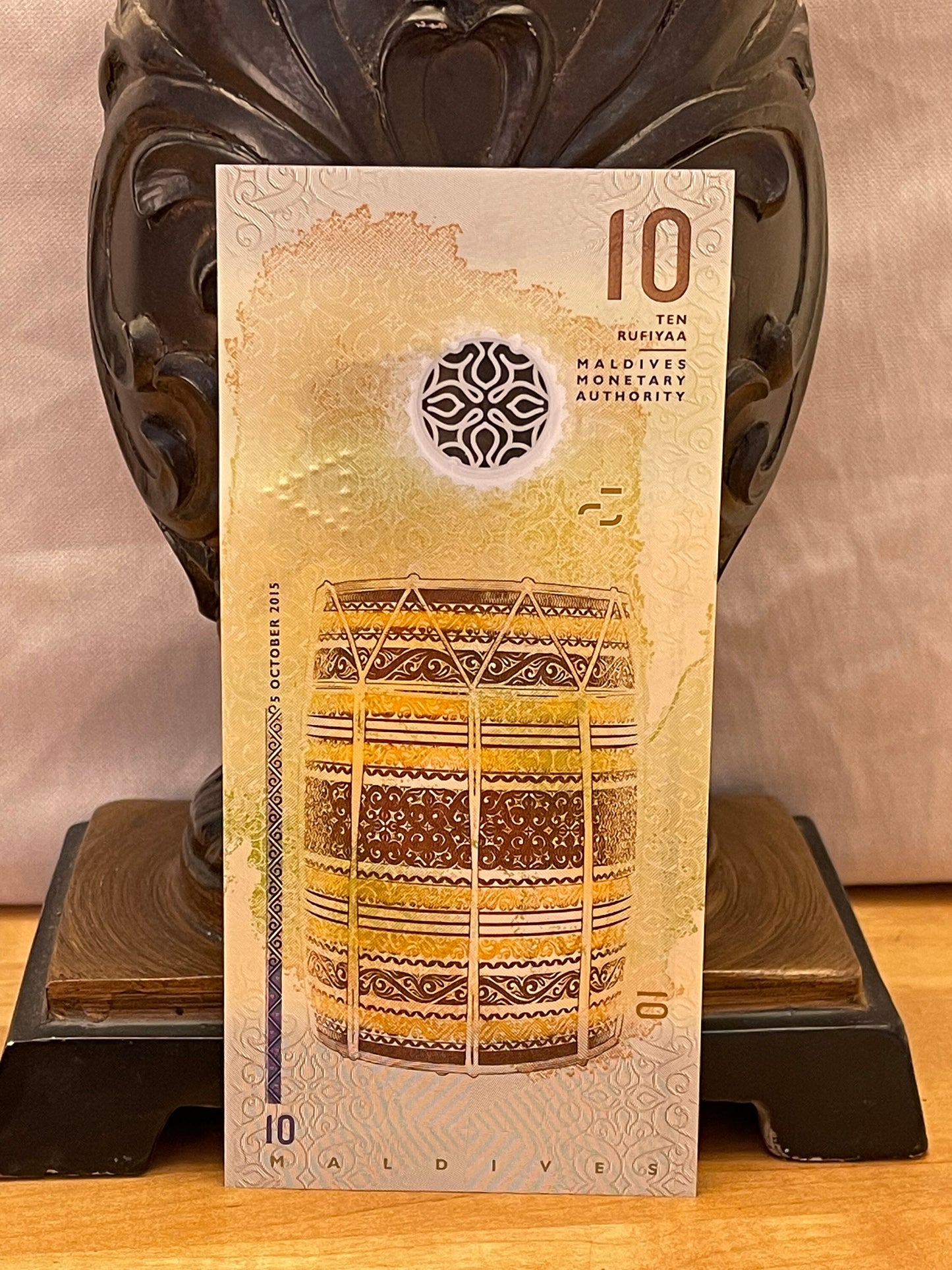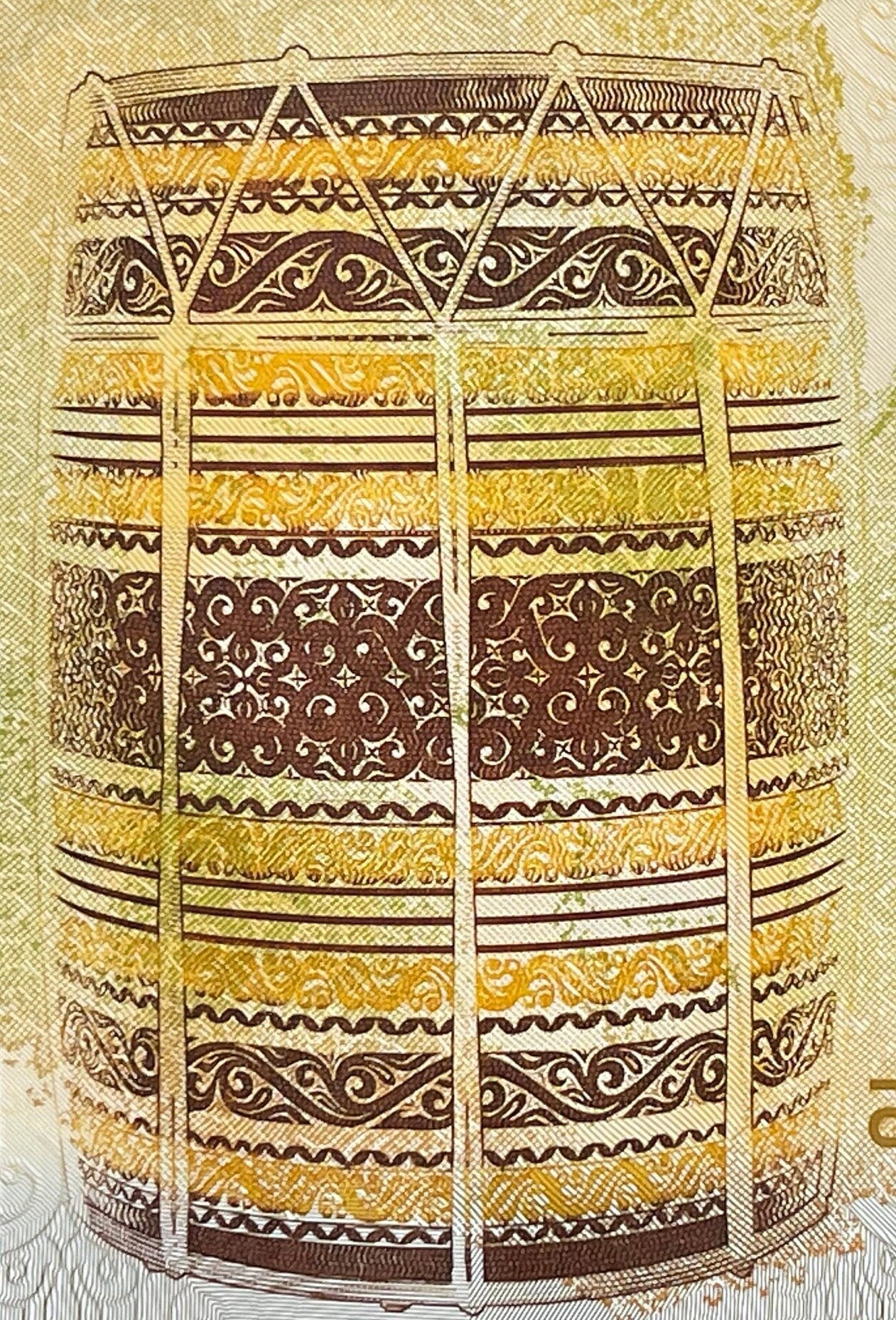elemintalshop
Tropical Palm Wine Tapper & Boduberu Drummers 10 Rufiyaa Maldives Authentic Banknote Money for Jewelry and Collage (Coconut Tree) (Polymer)
Tropical Palm Wine Tapper & Boduberu Drummers 10 Rufiyaa Maldives Authentic Banknote Money for Jewelry and Collage (Coconut Tree) (Polymer)
Couldn't load pickup availability
Tropical Palm Wine Tapper & Boduberu Drummers 10 Rufiyaa Maldives Authentic Banknote Money for Jewelry and Collage (Coconut Tree) (Polymer) (Drum Circle) (Toddy Tapper) (Polymer Note) (Island Paradise)
Polymer plastic banknote, with see-through watermark.
Obverse:
Foreground at right: Palm wine tapper climbing up a coconut palm tree. (In The Maldives, palm wine is called "dhoaraa, rukuraa, and meeraa".) Background center: Group of people playing Boduberu music on Bodu beru drums.
Reverse: The oldest Bodu beru drum in The Maldives.
Watermark: Transparent see-through plastic. Coat of arms of The Maldives
Features
Issuer Maldives
Period Second Republic (1968-date)
Type Standard banknote
Year 1436 (2015)
Calendar Islamic (Hijri)
Value 10 Rufiyaa
10 MVR = USD 0.65
Currency Rufiyaa (1947-date)
Composition Polymer
Size 150 × 70 mm
Shape Rectangular
Number N# 202599
References P# 26
Wikipedia:
Palm wine, known by several local names, is an alcoholic beverage created from the sap of various species of palm tree such as the palmyra, date palms, and coconut palms. It is known by various names in different regions and is common in various parts of Africa, the Caribbean, South America, South Asia, Southeast Asia and Micronesia.
Palm wine production by smallholders and individual farmers may promote conservation as palm trees become a source of regular household income that may economically be worth more than the value of timber sold.
The sap is extracted and collected by a tapper. Typically the sap is collected from the cut flower of the palm tree. A container is fastened to the flower stump to collect the sap. The white liquid that initially collects tends to be very sweet and non-alcoholic before it is fermented. An alternative method is the felling of the entire tree. Where this is practised, a fire is sometimes lit at the cut end to facilitate the collection of sap.
Palm sap begins fermenting immediately after collection, due to natural yeasts in the air (often spurred by residual yeast left in the collecting container). Within two hours, fermentation yields an aromatic wine of up to 4% alcohol content, mildly intoxicating and sweet. The wine may be allowed to ferment longer, up to a day, to yield a stronger, more sour and acidic taste, which some people prefer. Longer fermentation produces vinegar instead of stronger wine.
Distilled
Palm wine may be distilled to create a stronger drink, which goes by different names depending on the region (e.g., arrack, palm feni (liquor), village gin, charayam, and country whiskey).
Throughout Nigeria, this is commonly called Palm Wine. In some parts of Cameroon, it is known as Emu or "Matango". In parts of southern Ghana, distilled palm wine is called akpeteshi or burukutu. In Togo and Benin, it is called sodabe, while in Tunisia it is called lagmi. In coastal parts of Kenya, it is known as "mnazi".In India it is called "Toddy" Chang'aa can be applied to wounds to stop heavy bleeding (mechanism of action not known). In Ivory Coast, it is called "koutoukou".
Consumption by animals
Some small pollinating mammals consume large amounts of fermented palm nectar as part of their diet, especially the southeast Asian pen-tailed treeshrew. The inflorescences of the bertam palm contain populations of yeast which ferment the nectar in the flowers to up to 3.8% alcohol (average: 0.6%). The treeshrews metabolise the alcohol very efficiently and do not appear to become drunk from the fermented nectar.
Megabats have been known to drink from containers of harvested palm sap and then urinate into the containers, leading to the transmission of the Nipah virus.
*******
WIkipedia:
The Bodu beru is a Maldivian drum, made of wood from coconut tree trunk, and often grouped in trios. The instrument is used to accompany a dance of the same name, the Boduberu.
Boduberu is similar to some of the songs and dances found in east and south west Africa. It is likely that the music was introduced to The Maldives by sailors from the Indian Ocean region. It may be said that Boduberu first made an appearance in The Maldives in the 11th Century AD, or possibly before that.
Boduberu is performed by about 20 people, including three drummers and a lead singer. They are accompanied by a small bell, a set of drums also known as a bodu beru, and an onugandu - a small piece of bamboo with horizontal grooves, from which raspy sounds are produced by scraping. The songs may be of heroism, romance or satire. The prelude to the song is a slow beat with emphasis on drumming, and dancing. As the song reaches a crescendo, one or two dancers maintain the wild beat with their frantic movements ending in some cases in a trance.
The costume of the performers is a sarong and a white short sleeved shirt.
Boduberu evolved among the common citizens as an alternative to court music. In the early days, the people gathered together to perform Boduberu, and it became widely accepted as the music of the common people. The performing of the music is often referred as "vibrating the island". A notable point about Boduberu is its noise and sometimes meaningless lyrics sung. The lyrics do not have a meaning, because it consists of a mixture of local, neighbouring and some African words. Today, meaningful songs written in the local language Dhivehi are sung to the rhythm of Boduberu.
Boduberu is usually sung after a hard day's work. The location is up to the performers. Today, Boduberu is an important item of entertainment at stage shows, special occasions, celebrations and festivals.
Share

















